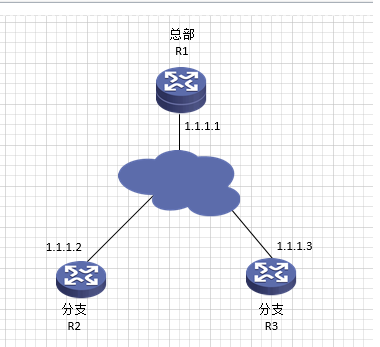SR88配置GRE OVER IPSEC,穿越NAT
- 0关注
- 1收藏,1532浏览
问题描述:
本端华三SR88,对端华为路由器,对端有NAT,需要一个配置案例
- 2024-07-19提问
- 举报
-
(0)

您好,请知:
以下是配置案例,请参考:
R1是总部路由器(V5平台),R2,R3为分支路由器(V7平台)。分支都要能够通过ipsec访问总部,并且需要通过ospf学习到总部路由。分支之间不需要互访。但是两个分支的内网网段地址重叠,都是192.168.1.0网段,会有地址冲突的情况。

IP地址规划如下:
设备 | 外网口IP | 内网口IP | Tunnel口IP |
R1 | 1.1.1.1/24 | 100.0.0.1 | TUN1:12.0.0.1/24 TUN2:13.0.0.1/24 |
R2 | 1.1.1.2/24 | 192.168.1.1/24 | 12.0.0.2/24 |
R3 | 1.1.1.3/24 | 192.168.1.1/24 | 13.0.0.3/24 |
由于客户需要分支通过ospf学习到总部路由,因此可考虑使用gre over ipsec的方案。但是由于分支端ip地址重叠,所以不能直接将分支端的网段通过ospf发给总部。解决的方法就是,在gre tunnel口上做一次nat,将分支的内网ip转换成tunnel口的ip来解决地址重叠的问题。
1. 总部R1配置:
1) 配置GRE tunnel,源是本端外网口IP,目的是对端外网口IP
#
interface Tunnel1
ip address 12.0.0.1 255.255.255.0
source 1.1.1.1
destination 1.1.1.2
#
interface Tunnel2
ip address 13.0.0.1 255.255.255.0
source 1.1.1.1
destination 1.1.1.3
#
2) 配置感兴趣流
#
acl number 3000
rule 0 permit ip source 1.1.1.1 0 destination 1.1.1.2 0
acl number 3001
rule 0 permit ip source 1.1.1.1 0 destination 1.1.1.3 0
#
在gre over ipsec的情况下,数据先进行gre封装,再进行ipsec加密。因此ipsec感兴趣流的源和目的IP是经过gre封装后的IP,也就是gre tunnel的 source和destination。
3) 配置ike peer
#
ike peer r2
pre-shared-key cipher $c$3$UYUBC/5zGBw77ZgZDLniBXst6B7ejQ==
remote-address 1.1.1.2
#
ike peer r3
pre-shared-key cipher $c$3$cUNdODztbuXP26+JFs3boP5G07NwMA==
remote-address 1.1.1.3
#
4) 配置ipsec transform-set
#
ipsec transform-set 1
encapsulation-mode tunnel
transform esp
esp authentication-algorithm md5
esp encryption-algorithm 3des
#
5) 配置 ipsec policy
#
ipsec policy 1 10 isakmp
security acl 3000
ike-peer r2
transform-set 1
#
ipsec policy 1 20 isakmp
security acl 3001
ike-peer r3
transform-set 1
#
6) 物理接口下调用ipsec policy
#
interface Ethernet0/0
port link-mode route
ip address 1.1.1.1 255.255.255.0
ipsec policy 1
#
7) 配置ospf,把内网口和tunnel口宣告进ospf
#
ospf 1
area 0.0.0.0
network 100.0.0.1 0.0.0.0
network 12.0.0.1 0.0.0.0
network 13.0.0.1 0.0.0.0
#
2. 分支R2配置:
1) 配置GRE tunnel
#
interface Tunnel0 mode gre
ip address 12.0.0.2 255.255.255.0
source 1.1.1.2
destination 1.1.1.1
nat outbound
#
Tunnel口上配置nat outbound,数据包经过tunnel口时,会先将源地址转换为tunnel口的地址,再进行gre封装。
2) 配置感兴趣流
#
acl advanced 3000
rule 0 permit ip source 1.1.1.2 0 destination 1.1.1.1 0
#
3) 配置ipsec策略
#
ipsec transform-set 1
esp encryption-algorithm 3des-cbc
esp authentication-algorithm md5
#
ipsec policy 1 10 isakmp
transform-set 1
security acl 3000
remote-address 1.1.1.1
ike-profile 1
#
ike profile 1
keychain 1
match remote identity address 1.1.1.1 255.255.255.255
#
ike keychain 1
pre-shared-key address 1.1.1.1 255.255.255.255 key cipher $c$3$Zjh8lqvsPg27z8WHRa4jIDOoxCmrjQ==
#
4) 物理接口下调用ipsec policy
#
interface GigabitEthernet0/0
port link-mode route
ip address 1.1.1.2 255.255.255.0
ipsec apply policy 1
#
5) 配置ospf,把内网口和tunnel口宣告进ospf
#
ospf 1
area 0.0.0.0
network 12.0.0.2 0.0.0.0
#
注意不要把内网口宣告进ospf。
3. 分支R3配置:
1) 配置GRE tunnel
#
interface Tunnel0 mode gre
ip address 13.0.0.3 255.255.255.0
source 1.1.1.3
destination 1.1.1.1
nat outbound
#
Tunnel口上配置nat outbound,数据包经过tunnel口时,会先将源地址转换为tunnel口的地址,再进行gre封装。
2) 配置感兴趣流
#
acl advanced 3000
rule 0 permit ip source 1.1.1.3 0 destination 1.1.1.1 0
#
3) 配置ipsec策略
#
ipsec transform-set 1
esp encryption-algorithm 3des-cbc
esp authentication-algorithm md5
#
ipsec policy 1 10 isakmp
transform-set 1
security acl 3000
remote-address 1.1.1.1
ike-profile 1
#
ike profile 1
keychain 1
match remote identity address 1.1.1.1 255.255.255.255
#
ike keychain 1
pre-shared-key address 1.1.1.1 255.255.255.255 key cipher $c$3$Zjh8lqvsPg27z8WHRa4jIDOoxCmrjQ==
#
4) 物理接口上调用ipsec策略
#
interface GigabitEthernet0/0
port link-mode route
combo enable copper
ip address 1.1.1.3 255.255.255.0
ipsec apply policy 1
#
5) 配置ospf,把tunnel口宣告进ospf
#
ospf 1
area 0.0.0.0
network 13.0.0.3 0.0.0.0
#
注意不要把内网口宣告进ospf。
4. 在总部端检查配置结果
1) 检查ike sa
total phase-1 SAs: 2
connection-id peer flag phase doi
----------------------------------------------------------------
142 1.1.1.3 RD 1 IPSEC
380 1.1.1.2 RD|ST 1 IPSEC
358 1.1.1.3 RD 2 IPSEC
381 1.1.1.2 RD|ST 2 IPSEC
flag meaning
RD--READY ST--STAYALIVE RL--REPLACED FD--FADING TO--TIMEOUT RK—REKEY
两个分支端的ipsec sa和ike sa都协商起来。
2) 检查ipsec sa
===============================
Interface: Ethernet0/0
path MTU: 1500
===============================
-----------------------------
IPsec policy name: "1"
sequence number: 10
acl version: ACL4
mode: isakmp
-----------------------------
PFS: N, DH group: none
tunnel:
local address: 1.1.1.1
remote address: 1.1.1.2
flow:
sour addr: 1.1.1.1/255.255.255.255 port: 0 protocol: IP
dest addr: 1.1.1.2/255.255.255.255 port: 0 protocol: IP
[inbound ESP SAs]
spi: 0x3356AE14(861318676)
transform: ESP-ENCRYPT-3DES ESP-AUTH-MD5
in use setting: Tunnel
connection id: 101
sa duration (kilobytes/sec): 1843200/3600
sa remaining duration (kilobytes/sec): 1843180/2950
anti-replay detection: Enabled
anti-replay window size(counter based): 32
udp encapsulation used for nat traversal: N
[outbound ESP SAs]
spi: 0x4054B36C(1079292780)
transform: ESP-ENCRYPT-3DES ESP-AUTH-MD5
in use setting: Tunnel
connection id: 102
sa duration (kilobytes/sec): 1843200/3600
sa remaining duration (kilobytes/sec): 1843180/2950
anti-replay detection: Enabled
anti-replay window size(counter based): 32
udp encapsulation used for nat traversal: N
===============================
Interface: Ethernet0/0
path MTU: 1500
===============================
-----------------------------
IPsec policy name: "1"
sequence number: 20
acl version: ACL4
mode: isakmp
-----------------------------
PFS: N, DH group: none
tunnel:
local address: 1.1.1.1
remote address: 1.1.1.3
flow:
sour addr: 1.1.1.1/255.255.255.255 port: 0 protocol: IP
dest addr: 1.1.1.3/255.255.255.255 port: 0 protocol: IP
[inbound ESP SAs]
spi: 0x891907CB(2300118987)
transform: ESP-ENCRYPT-3DES ESP-AUTH-MD5
in use setting: Tunnel
connection id: 99
sa duration (kilobytes/sec): 1843200/3600
sa remaining duration (kilobytes/sec): 1843158/758
anti-replay detection: Enabled
anti-replay window size(counter based): 32
udp encapsulation used for nat traversal: N
[outbound ESP SAs]
spi: 0x8FE5123C(2414154300)
transform: ESP-ENCRYPT-3DES ESP-AUTH-MD5
in use setting: Tunnel
connection id: 100
sa duration (kilobytes/sec): 1843200/3600
sa remaining duration (kilobytes/sec): 1843159/758
anti-replay detection: Enabled
anti-replay window size(counter based): 32
udp encapsulation used for nat traversal: N
两个sa的保护流,是gre封装后的源和目的ip。
3) 检查ospf 邻居
OSPF Process 1 with Router ID 100.0.0.1
Neighbor Brief Information
Area: 0.0.0.0
Router ID Address Pri Dead-Time Interface State
1.1.1.2 12.0.0.2 1 32 Tun1 Full/ -
192.168.1.1 13.0.0.3 1 37 Tun2 Full/ -
与两个分支tunnel口的邻居都是full状态。邻居地址是tunnel口ip地址。
5. 分支端进行测试,从两个分支,用各自的内网地址telnet总部的内网地址
能同时telnet到总部路由器上
6. 总部端查看telnet用户在线状态
The user application information of the user interface(s):
Idx UI Delay Type Userlevel
82 VTY 0 00:00:46 TEL 3
+ 83 VTY 1 00:00:00 TEL 3
84 VTY 2 00:00:19 TEL 3
Following are more details.
VTY 0 :
Location: 12.0.0.2
VTY 1 :
Location: 1.1.1.4
VTY 2 :
Location: 13.0.0.3
+ : Current operation user.
F : Current operation user work in async mode.
分2个分支端用户可以同时在线,源ip是各分支tunnel口的ip
1、本配置是GRE OVER IPSEC,因此IPSEC感兴趣流acl要匹配GRE封装后的数据包的地址,并且要互为镜像。
2、在GRE OVER IPSEC中,IPSec应用在物理口上。
3、Tunnel口上配置nat outbound,数据包经过tunnel口时,会先将源地址转换为tunnel口的地址,再进行gre封装。
- 2024-07-19回答
- 评论(0)
- 举报
-
(0)
暂无评论
编辑答案


亲~登录后才可以操作哦!
确定你的邮箱还未认证,请认证邮箱或绑定手机后进行当前操作
举报
×
侵犯我的权益
×
侵犯了我企业的权益
×
- 1. 您举报的内容是什么?(请在邮件中列出您举报的内容和链接地址)
- 2. 您是谁?(身份证明材料,可以是身份证或护照等证件)
- 3. 是哪家企业?(营业执照,单位登记证明等证件)
- 4. 您与该企业的关系是?(您是企业法人或被授权人,需提供企业委托授权书)
抄袭了我的内容
×
原文链接或出处
诽谤我
×
- 1. 您举报的内容以及侵犯了您什么权益?(请在邮件中列出您举报的内容、链接地址,并给出简短的说明)
- 2. 您是谁?(身份证明材料,可以是身份证或护照等证件)
对根叔社区有害的内容
×
不规范转载
×
举报说明



暂无评论